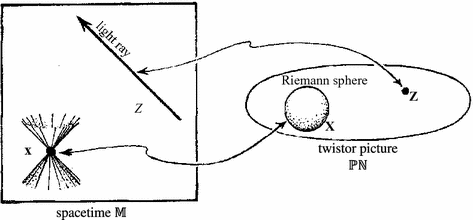Since last summer Eric Weinstein has been running a podcast entitled The Portal, featuring a wide range of unusual and provocative discussions. A couple have had a physics theme, including one with Garrett Lisi back in December.
One that I found completely fascinating was a recent interview with Roger Penrose. Penrose of course is one of the great figures of theoretical physics, and someone whose work has not followed fashion but exhibited a striking degree of originality. He and his work have often been a topic of interest on this blog: for one example, see a review of his book Fashion, Faith and Fantasy.
Over the years I’ve spent a lot of time thinking about Penrose’s twistors, becoming more and more convinced that these provide just the radical new perspective on space-time geometry and quantization that is needed for further progress on fundamental theory. For a long time now, string theorists have been claiming that “space-time is doomed”, and the recent “it from qubit” bandwagon also is based on the idea that space-time needs to be replaced by something else, something deeply quantum mechanical. Twistors have played an important role in recent work on amplitudes, for more about this a good source is a 2011 Arkani-Hamed talk at Penrose’s 80th birthday conference.
One of my own motivations for the conviction that twistors are part of what is needed is the “this math is just too beautiful not to be true” kind of argument that these days many disapprove of. There are many places one can read about twistors and the mathematics that underlies them. One that I can especially recommend is the book Twistor Geometry and Field Theory, by Ward and Wells. A one sentence summary of the fundamental idea would be
A point in space time is a complex two-plane in complex four-dimensional (twistor) space, and this complex two-plane is the fiber of the spinor bundle at the point.
In more detail, the Grassmanian G(2,4) of complex two-planes in $\mathbf C^4$ is compactified and complexified Minkowski space, with the spinor bundle the tautological bundle. So, more fundamental than space-time is the twistor space T=$\mathbf C^4$. Choosing a Hermitian form $\Omega$ of signature (2,2) on this space, compactified Minkowski space is the set of two-planes in T on which the form is zero. The conformal group is then the group SU(2,2) of transformations of T preserving $\Omega$ and this setup is ideal for handling conformally-invariant theories. Instead of working directly with T, it is often convenient to mod out by the action of the complex scalars and work with $PT=\mathbf{CP}^3$. A point in complexified, compactified space-time is then a $\mathbf{CP}^1 \subset \mathbf{CP}^3$, with the real Minkowski (compactified) points corresponding to $\mathbf{CP}^1$s that lie in a five-dimensional hypersurface $PN \subset PT$ where $\Omega=0$.
On the podcast, Penrose describes the motivation behind his discovery of twistors, and the history of exactly how this discovery came about. He was a visitor in 1963 at the University of Texas in Austin, with an office next door to Engelbert Schucking, who among other things had explained to him the importance in quantum theory of the positive/negative energy decomposition of the space of solutions to field equations. After the Kennedy assassination, he and others made a plan to get together with colleagues from Dallas, taking a trip to San Antonio and the coast. Penrose was being driven back from San Antonio to Austin by Istvan Ozsvath (father of Peter Ozsvath, ex-colleague here at Columbia), and it turned out that Istvan was not at all talkative. This gave Penrose time alone to think, and it was during this trip he had the crucial idea. For details of this, listen to what Penrose has to say starting at about 47 minutes before the end of the podcast. For a written version of the same story, see Penrose’s article Some Remarks on Twistor Theory, which was a contribution to a volume of essays in honor of Schucking.


